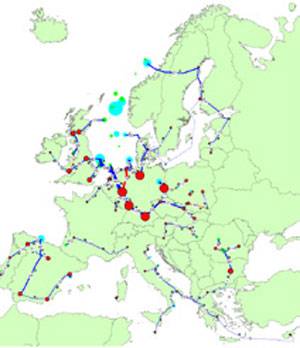Trans-European Optimization of CO2 Transport Network
The recently published JRC report on "The evolution of the extent and the investment requirements of a trans-European CO2 transport network" describes the potential evolution of the CO2 transmission infrastructure at the European scale until 2050 in terms of physical size and capital cost requirements.
Carbon capture and storage (CCS) is considered as one of the most promising technological options for reducing CO2 emissions from power plants, as well as from other heavy industries, offering a bridge from the fossil fuels-dependent economy to a carbon-free future. Large-scale deployment of CCS in Europe will require the development of new infrastructure (e.g. network of pipelines and shipping routes) to transport the captured CO2 from its sources (e.g. power plants) to the appropriate CO2 storage sites. However, the results of this analysis depend strongly on the assumptions that have been made, in particular of the long-term horizon of the analysis, the uncertainty of CCS deployment rates and timelines, the lack of robust data on CO2 storage sites and the variability of pipeline construction costs. According to the report, the size of the CCS network will grow steadily until 2030 to 8800 km, requiring around $11.7b of cumulative investment. Towards 2050, a step-change should occur, leading to a total investment of around $37.9b. This is based on a relatively conservative scenario of CCS deployment, as the amount of CO2 captured in 2050 will not meet the ambition for the decarbonization of European society by then.
Scenarios compatible with the European vision for a decarbonised society in 2050, which will require the capture of almost all CO2 emissions from both the power and the industrial sectors, would be associated with a more extensive and hence more expensive CO2 transport network. By 2030, 16 EU Member States may be involved in cross-border CO2 transport. International coordination is therefore crucial for the development of an optimized trans-European CO2 transport network.














